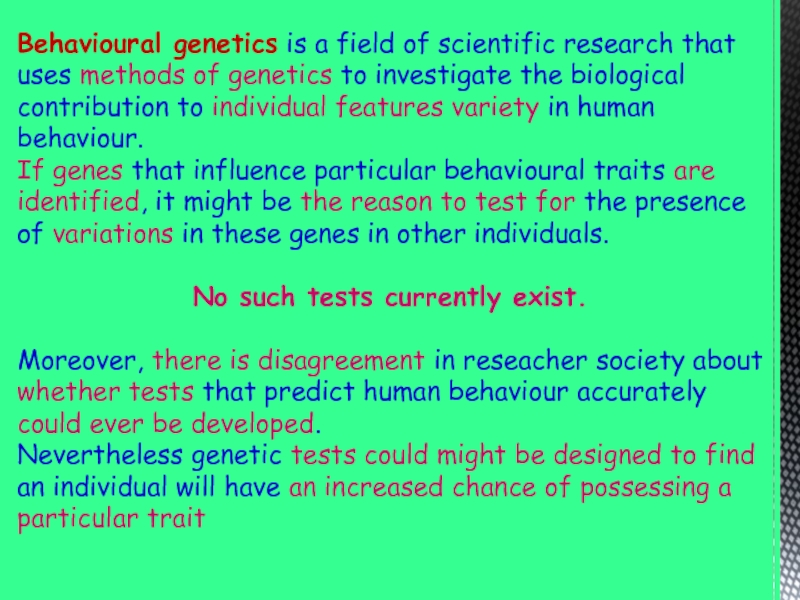Слайд 1Introduction:
the subject and basics
Methods in behavioral genetics
Слайд 2Behavioural genetics is a field of scientific research that uses
methods of genetics to investigate the biological contribution to individual
features variety in human behaviour.
If genes that influence particular behavioural traits are identified, it might be the reason to test for the presence of variations in these genes in other individuals.
No such tests currently exist.
Moreover, there is disagreement in reseacher society about whether tests that predict human behaviour accurately could ever be developed.
Nevertheless genetic tests could might be designed to find an individual will have an increased chance of possessing a particular trait
Слайд 3Such hypothetical tests might be undertaken for a variety of
purposes.
1. to gain more knowledge about the influence of
genes on behaviour.
2. for intervention or treatment, for example to prevent aggressive behaviour by using medicines, or by attempts to change relevant aspects of the environment.
3. for selection. This encompasses, for instance, prenatal testing, the streaming of children in schools on the basis of intelligence and aptitude, the screening of employees and jobseekers to exclude those with traits that employers consider undesirable, and the use by insurers of genetic information about behaviour and personality traits in order to estimate risk.
4. to claim diminished legal responsibility for one’s actions or to mitigate punishment for criminal behaviour
Слайд 4The scope of research in behavioural genetics
Main focus is on
four areas of research in behavioural genetics: research into intelligence,
personality traits, antisocial behaviour and sexual orientation, because of the important issues they raise.
■ Intelligence is a complex phenomenon and there is considerable debate about whether it can be measured effectively. There is substantial disagreement regarding the extent to which genetic and environmental factors influence it.
■ Personality traits have been studied by psychologists for many years. Five core traits have been the focus of research in both psychology and behavioural genetics: neuroticism, introversion/extraversion, openness, agreeableness and conscientiousness.
■ Antisocial behaviour is classified differently by mental health clinicians, criminologists and psychologists, but a common factor is that it is behaviour which violates the rights and safety of others. It includes traits such as aggression and violent behaviour.
■ Sexual orientation is regarded by some as a matter of choice and by others as a matter of biology. What role, if any, do genetic factors play in sexual orientation? The answer to this question is bound to influence the way in which people react to homosexuality.

Слайд 5The main difficulties
The connection between genes and diseases is far
from clarity, and the relationship between genes and behaviour is
even more complicated. It is often difficult to establish which genes contribute to a trait and how they do so because:
■ More than one genetic factor usually contributes to a particular trait
■ These multiple genetic factors may interact with each other and have different effects depending on which other factors are present in the individual’s genotype.
■ As well as genetic factors, many non-genetic (environmental) ones may contribute to the manifestation of a trait.
■ These environmental factors may also interact with each other.
■ The genetic factors may affect which environmental ones have an effect. (This is called gene–environment interaction.)
■ Conversely, environmental factors may affect which genetic ones have an effect.
■ Certain genetic and environmental factors may go hand in hand. (This is called gene–environment correlation.)
■ A protein may be modified after it has been produced from a gene, and this can alter its function.
■ Genes do not have a continuous effect in our bodies. They may be turned on and off, both during our overall development and within the lifetime of an individual cell.

Слайд 6The main apprehensions
Despite being argued impossibility of making any robust
predictions based on genetic tests, or to design any effective
interventions as a result of them, it does not mean these considerations do exempt us from potential anxieties aroused by popular beliefs about this subject.
For in the past, social policies, for example eugenic policies, have been built on minimal or erroneous scientific foundations.
More recently misunderstandings about genetics have led to unwarranted discrimination.
Probably in the future it may become possible to make predictions, albeit limited ones, about behaviour based on genetic information and to design useful applications of this knowledge.
Anyway, our purpose is to outline main reliable methods in behavioural genetics which have proved their efficiency
Слайд 7Reporting research in behavioural genetics
Quantitative genetics
■ Quantitative genetics involves statistical
methods that attempt to distinguish the effects of genetic and
environmental factors on variation in certain behavioural traits, which can be quantitatively measured, between groups of individuals.
■ The subjects of the research are usually twins, siblings, adopted children, and families.
■ The statistics such as estimates of heritability generated by the research refer to groups of people, not to individuals. Nor do they refer to particular genes or regions of DNA or to specific environmental factors.
This last requires further research and additional measurement.
■ Estimates of heritability and other statistical techniques are useful in understanding the relative contribution of different types of influence and their relation to each other despite the fact they do not lead directly to predictive information regarding individuals, nor do they give reliable estimates of how strongly predictive a genetic test might be if it were developed.
Слайд 8Molecular genetics
■ Research in molecular genetics tries to identify variation
in particular genes that influences behaviour, by examining the DNA
of individuals.
■ This is difficult because there are usually many genes involved, each of which may only have a small effect. Many associations between a genetic variant and a behavioural trait have been reported but have not been successfully repeated by other researchers.
■ In most cases, the research does not explain how the gene influences the behaviour. However, some researchers predict that these difficulties are possibly overcoming and that genes that influence behaviour will be reliably identified .
Слайд 9Research involving animals
■ Animal models have greatly advanced our understanding
of how genes have an effect in the organism and
of how the brain develops.
■ Animal models can be created by various techniques including selective breeding and the direct manipulation of specific genes.
■ Although there are many similarities with regard to genetics between human and non-human animals, there are also considerable differences in the expression of their genes both within the organism and over time.
■ It is difficult to equate directly the richness of complex human traits such as intelligence, personality and sexual orientation with the behaviour of animals. This may limit the potential value of the research.
■ For these reasons, caution should be exerted when hypothesising that genes studied in research involving animals will have the same effect in humans.
Слайд 11
Revising of Mendel rules
General approaches to an estimation of heritability
Pedigree
method
Twins method
Adopted children studies
Population studies






























